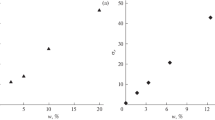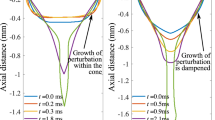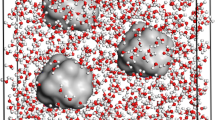Abstract
A multipole re-expansion solution for two nonidentical dielectric spheres in a parallel electric field is used to determine the critical ratio of particle radii which leads to the strongest force of attraction between the spheres at various interstices and under varying dielectric properties. These critical ratios provide genuine optimal dimensions, in the sense that the force of attraction decreases for both increasing and decreasing ratios. Numerical results are compared with experimental results from the literature and discussed from the perspective of the impact on the design of electrorheological nanofluids.





Similar content being viewed by others
References
Davis MH (1964) Two charged spherical conductors in a uniform electric field: forces and field strength. Q J Mech Appl Math 17:499–511
Matsuyama T, Yamamoto H, Washizu M (1995) Potential distribution around a partially charged dielectric particle located near a conducting plane. J Electrost 36:195–204
Nakajima Y, Sato T (1999) Calculation of electrostatic force between two charged dielectric spheres by the re-expansion method. J Electrost 45:213–226
Ota M, Miyamoto T (1994) Optimum particle size distribution of an electrorheological fluid. J Appl Phys 76:5528–5532
Parthasarathy M, Klingenberg DJ (1996) Electrorheology: mechanisms and models. Mater Sci Eng R17:57–103
See H, Kawai A, Ikazaki F (2002) The effect of mixing particles of different size on the electrorheological response under steady shear flow. Rheol Acta 41:55–60
Washizu M (1992) Precise calculation of dielectrophoretic force in an arbitrary field. J Electrost 29:177–188
Wu CW, Conrad H (1998) Influence of mixed particle size on electrorheological response. J Appl Phys 83:3880–3884
Acknowledgement
The support of the Australian Research Council through the Discovery Project Grant Scheme is gratefully acknowledged.
Author information
Authors and Affiliations
Corresponding author
Appendix
Appendix
A derivation of the re-expansion formula
The re-expansion method was suggested by Washizu (1992) and was employed by Matsuyama et al. (1995) to derive an axisymmetric re-expansion at another point on the axis of symmetry. In this appendix, we give a clearer view of the derivation of the re-expansion formula (Eq. 4). The method of the derivation follows that employed by Matsuyama et al. (1995). The result of Eq. 3 can be quickly derived using the same argument as that below and has not been included in this appendix.
Consider a Cartesian coordinate system with a potential which is axisymmetric around the z-axis. Now take two distinct points on the z-axis and centre separate axisymmetric spherical coordinate systems (r, θ) and (R, Θ) around these two points, where the first coordinate system is to the left (negative z direction) of the second, and the angles are measured in an anti-clockwise direction from the positive z direction. Figure 6 shows a common point being referenced in either polar coordinate system.
Let there be potentials centred on each of the polar origins, each with a singularity at r→∞ and R=0, respectively. These potentials can be expanded with a Legendre expansions as
where \(\phi _{n} = r^{n} {\bf P}_{n} {\left( {\cos \Theta } \right)},\psi _{n} = R^{{ - {\left( {n + 1} \right)}}} {\bf P}_{n} {\left( {\cos \Theta } \right)},\)and a n and A n are the coefficients of the expansion.
Now, differentiating φ n and ψ n with respect to z and noting that \(\partial \mathord{\left/ {\vphantom {\partial {\partial z}}} \right. \kern-\nulldelimiterspace} {\partial z} = \cos \theta \,\partial \mathord{\left/ {\vphantom {\partial {\partial r}}} \right. \kern-\nulldelimiterspace} {\partial r} - {\left( {\sin \theta \mathord{\left/ {\vphantom {\theta r}} \right. \kern-\nulldelimiterspace} r} \right)}\partial \mathord{\left/ {\vphantom {\partial {\partial \theta }}} \right. \kern-\nulldelimiterspace} {\partial \theta }{\kern 1pt}\)we yield
and using following identities of Legendre polynomials
we can state
Now, considering the figure above and applying the cosine rule, we can immediately see that \(R^{2} = d^{2} - 2rd\,\,\,\,\cos \theta + r^{2} ,\)which allows us to quickly derive
Noting that ψ 0=1/R and that a generating function for the Legendre polynomials is
we can therefore state
Now, considering the recurrence relationships (Eq. 34), we can make the following rearrangements:
Therefore, by substituting in for ϕ m , ψ n , multiplying both sides by \(r^{{n + 1}}_{{\text{b}}}\) and rearranging, we yield the required re-expansion
Rights and permissions
About this article
Cite this article
Cox, B.J., Thamwattana, N. & Hill, J.M. Maximising the electrorheological effect for bidisperse nanofluids from the electrostatic force between two particles. Rheol Acta 45, 909–917 (2006). https://doi.org/10.1007/s00397-006-0084-4
Received:
Accepted:
Published:
Issue Date:
DOI: https://doi.org/10.1007/s00397-006-0084-4





